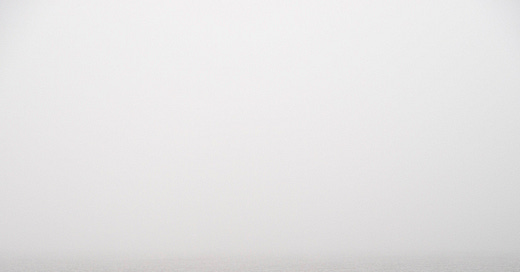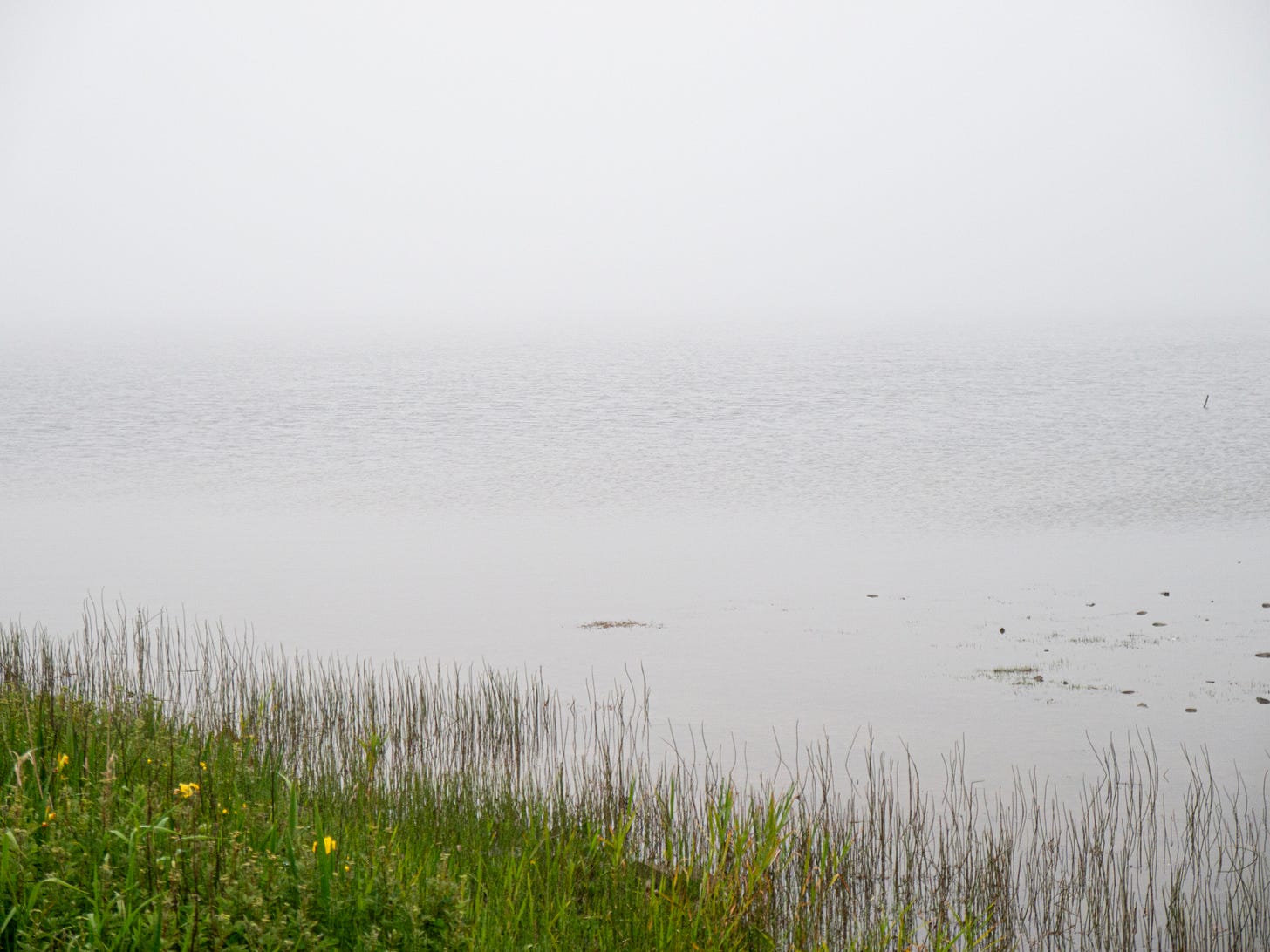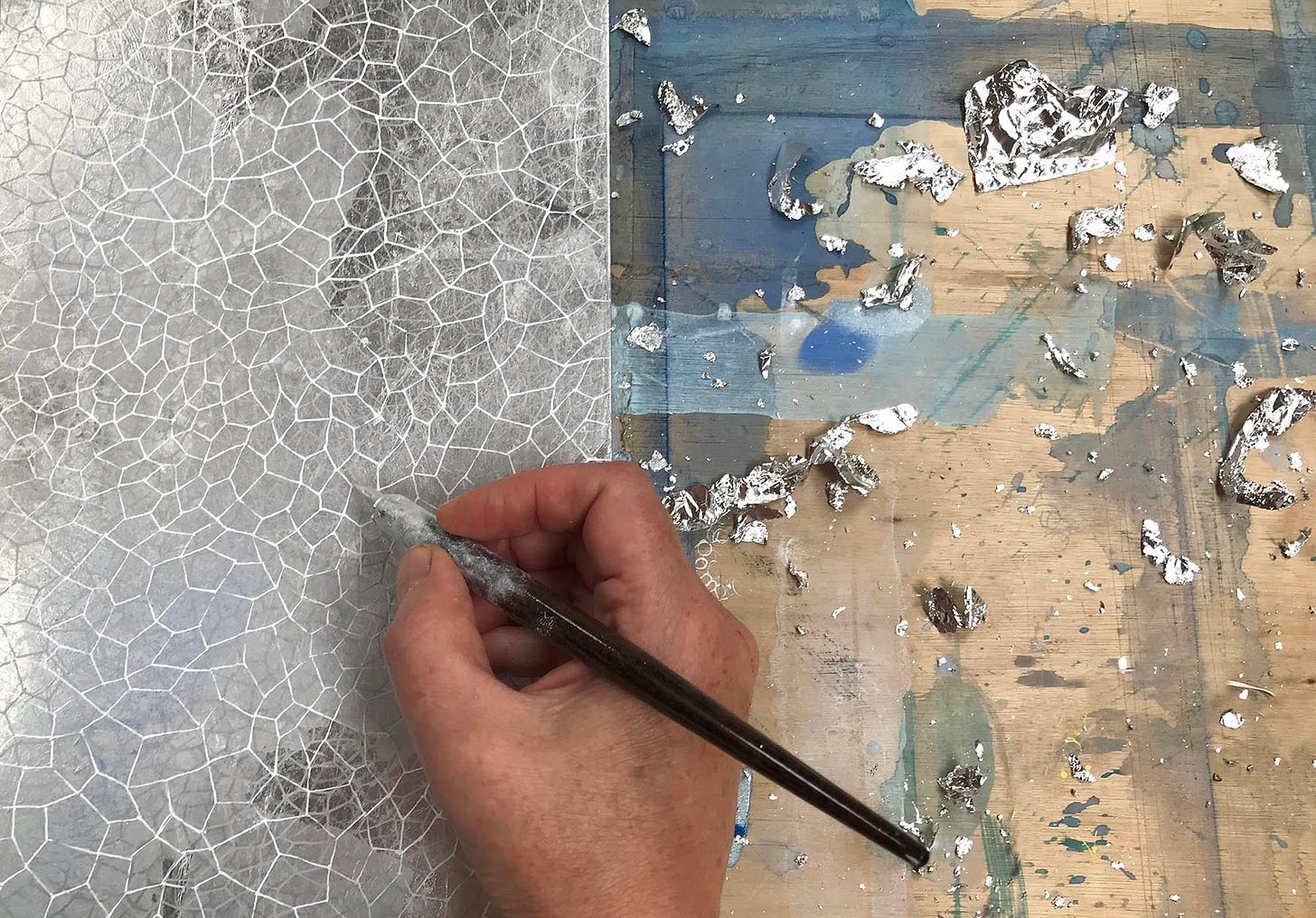Hello friends
After a day of quiet, steady rain, a mist coalesces silently, as if it’s rising from the soaked summer fields. The loch fades to nothing more than a darker smudge in a shining field of grey-white.
The light is colloidal. The midsummer sunlight is still there, a luminousity through the fog. When I look into its bright milkiness my eyes dance with floaters. Are they in my eyeballs? Or are they in the air itself?
Air is filled with life. It’s a soup, swimming with active compounds released by green plants, with bacteria, spores, seeds, salt, Saharan dust, with winged creatures, with spiders ballooning on drifting silk, with all manner of smokes and smogs, shreds of car tyres and bits of plastic.
I feel its mild dampness against my face. In its windless blur, bird sounds carry. The sedge warbler is back from his travels and is shouting the news, ratcheting and darting busily among the flag iris. A mallard duck, with just one half-grown survivor of her brood, quacks in alarm and hurries her duckling away from me. An arctic tern flicks into sight, white on white with a crisp black cap, and is gone again. As
wrote so beautifully a while back, a bird is a creature of the air. Their bodies are “laced with sky”, none more so than the tern’s.So are our own bodies laced with sky. We are filled with air and water and light. Take a deep breath and feel, for a moment, the airy space that opens inside you. Feel the liquid pulsing in your veins and lubricating your eyes and mouth. Press your fingers to your closed eyelids and see the kaleidoscope of light that sparks inside your eyeballs. Or look, as I did, at the whiteness of fog and see the sparking and wriggling that is either inside or outside you and neither and both.
I’ve just embarked on a big read; Evan Thompson’s ‘Mind in Life’. It’s the kind of book that demands careful attention and a pencil in hand to make margin notes, the kind of book I haven’t read in a while but want to make more time for. I’m not far enough in yet to give a detailed overview but I was drawn to reading it because Thompson explores the idea of ‘embodied cognition’.
This is a way of understanding thought as something we do with the world, rather than something that goes on inside the bonebox of our head, about a world that’s outside it. As Thompson writes: “Mental life is bodily life and is situated in the world’
He goes on:
“The roots of mental life lie not simply in the brain but ramify through the body and its environment. Our mental lives involve our body and the world beyond the surface membrane of our organism.”
Seeing, then, isn’t peering out through our watery eyeballs at a world ‘out there’ and trying to make sense of it. Thompson understands all our perception as inherently relational, something emergent that arises between our intelligence and the world as it is given to our senses. We think in and with the landscape around us.
I’ve been thinking about what this idea of embodied cognition brings to painting, specifically landscape painting. What does it mean to paint, or draw, in response to a place? It’s certainly about more than seeing it better, although attentiveness is part of it. And it’s more than re-presenting it, although that’s part of it too.
After a session picking my way through Evan Thompson, I was leafing through a hefty monograph I picked up when in London, when I read an essay by the artist Richard Wright that seemed to connect the dots for me:
“Painting is an act that connects reality and consciousness. It is more than a collective codification of signs. It is a delirium of vision. Drawing describes the mind in the act of seeing, but this action comes before consciousness. It is only through touching this concrete world I can leave myself. The silence of things is disturbed into vibration. The task is not conceived, it is understood; it is lived. The painter goes out into the world and momentarily changes the order of things. The hand has grown to be part of the tool and the tool has grown to be part of everything that surrounds it. If there is knowledge here it resides in the muscles”
Wright is, it seems to me, describing painting (and drawing) as a kind of embodied cognition. It’s seeing as a material activity, muscular, and intelligent.
“The very tip of the pen, the exact place where I touch the material of things, is nothing, but at the same time it is the concrete point between the senses and the seeing world. Its articulation permits an ecstasy of presence: a softening of the boundary between an inner and outer. One becomes the other and the other becomes one.”
Painting is a way of acting in the world, and of being acted upon. It’s relational and reciprocal:
“Practice is the process of becoming. I work the material and the material works me….In repetition the hand and eye are joined to the world.”
Everything meets in that teetering moment as the tip of the pen or brush touches the surface, as you negotiate with the physicality of paint that would rather spill, smudge and stain your fingers and a recalcitrant body that, as Wright wrily observes, ‘would rather look at its phone.’
This is what keeps bringing me back to this work day after day, this activity of looking/making/thinking/drawing. Patiently, thread by thread, line by line, I am lacing myself, body and mind, into this sky and water and air and land, and the landscape is lacing itself into me.
And I think this is what brings me to look at paintings too. Through the recorded gesture of another human’s hand I can re-enter their embodied cognition, and so enter that moment in their world, and make it my own.
As Wright says:
“Painting knows how it got here. It is a material record of its own coming into being…You can see the light of the day on which it was made, you can hear the chatter in the artisan’s mind and feel the breath held in that moment of silence when the stroke is drawn upwards and released. All this is right there in front of you”
I’ll be showing some recent and new paintings as part of “Making Waves - Breaking Ground” at Bowhouse in Fife, in July and August. Curated by Sophie Camu in association with Purdy Hicks Gallery, you can find out more about the exhibition here.
I’ll also be releasing a suite of little paintings direct from my studio soon, exclusively to subscribers, so do keep an eye on your inbox as the last lot sold out within just three hours!
The Life Raft Co-Creating Community
If you would like to connect with your own creative work and other writers and artists, you’re welcome to join our weekly creative co-working session on Zoom. It’s very simple. We just say hello at the start and say what we plan to work on and then leave our cameras on and work together in companionable silence. We start at 3pm UK time and finish around 4.30pm. Just click the link below to join us.
That’s all for this week!
Sam












Really love how you relate embodied cognition to painting. I've spent a lot of time thinking about embodied cognition in the context of animal intelligence and perception, but never art - and yes! So much to chew on here! You might be interested in the work of Louise Barrett. Her book Beyond the Brain explores embodied cognition in humans and nonhumans and is (I think) an incredibly rich read.
My painter girlfriend who lived in New York, Susanna Heller, was quoted in an article, after navigating through some personal challenges, as saying I survive on the tip of my pencil